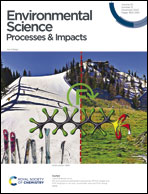Per- and polyfluoroalkyl substances (PFAS) in grocery store foods: method optimization, occurrence, and exposure assessment†
Abstract
Dietary exposure to per- and polyfluoroalkyl substances (PFAS) is poorly understood. Evaluating PFAS in food is complicated by the need to evaluate varied matrices and a lack of a standard, matrix-specific sample extraction methods. Prior food studies implemented universal rather than matrix-specific extraction approaches, which may yield false negatives and an underestimation of PFAS dietary exposure if methods are not suitable to all matrices. Here the objectives were to screen and optimize PFAS extraction methods for plants, tissues, and dairy; apply optimized extraction methods to a grocery store food survey; and compare estimated exposure to published reference doses (RfDs). Optimized, matrix-specific extractions generally yielded internal standard recoveries of 50–150% and matrix spike recoveries of 70–130%. The frequency of PFAS detection in grocery store foods (16 of 22 products) was higher than in previous work. PFAS were detected at concentrations of 10 ng kgdw−1 (perfluorobutane sulfonate; washed green beans and perfluorohexanoic acid; unwashed tomato) to 2680 ng kgdw−1 (perfluorohexane sulfonate; radish). Concentrations of perfluorooctanoic acid (PFOA) in carrots, lettuce, radish, and canned green beans yielded median exposure intake (EI) values of 0.016–0.240 ng per kgbw-day, which exceeded the EPA RfD (0.0015 ng per kgbw-day). Washing reduced radish PFOA concentrations below detection, but EIs at the reporting limit still exceeded the RfD. The combination of improved data quality and greater frequency of PFAS detection vs. prior studies plus EI > RfD for some PFAS suggests a need for matrix-specific extractions and analysis of PFAS in additional grocery store foods from broader geographic regions.

- This article is part of the themed collection: Environmental exposure and impacts


 Please wait while we load your content...
Please wait while we load your content...